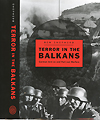
Terror in the Balkans: German Armies and Partisan Warfare, by Ben Shepherd, Harvard University Press, Cambridge, Mass., 2012, $45
Seven decades removed from World War II, we do not yet have an authoritative narrative history that untangles the snarl of ethnic hatred, historic resentment, territorial ambition and religious fanaticism that turned Yugoslavia into one of the bloodiest killing grounds of the entire conflict. The place was never anything but a disturbed wasp’s nest of a country, but in the war it became something more, a scene of ruthless terror and savagery. It became a war not merely of the Yugoslav people against the Nazis but of all against all, as in Thomas Hobbes’ original state of nature—Serbs vs. Partisans, Ustase vs. Serbs, Muslim vs. Christian, Partisans vs. Nazis, a whole subset of civil wars inside the main conflict. And all sides pursued it without a trace of pity or restraint. No wonder historians often shy away from the subject.
To simplify his narrative of the extremely complex conflict, Ben Shepherd has largely ignored the bitter civil wars and focused on Nazi conduct in Yugoslavia during World War II and its origins in German and Austrian warfare against irregular troops during World War I. He blames the Wehrmacht’s failure to win, or even make significant progress, in Yugoslavia on Germany’s contempt for guerrilla fighters—and its consequent underestimation of their effectiveness—and in its reliance on terror to cow the population into quiescence. Early on the Wehrmacht adopted a policy of hanging or shooting 100 civilians for every German soldier who was killed, and 50 for every one injured. As if this weren’t bad enough, the Nazis shot unarmed civilians on the slightest suspicion during campaigns in the countryside and laid waste whatever landscape they passed through.
None of this worked, as Shepherd relates, and his book takes a hard look at military minds locked in preconceptions, unable to think outside their particular boxes. The book is not brilliantly written, but it has vivid moments and elicits all the fascination of watching snakes fight. Readers will have to wait for the big narrative overview the subject demands, but that will require a historian willing to wade through the endless hatreds dividing the Balkans, and a landscape deeply soaked in blood.
—Anthony Brandt




